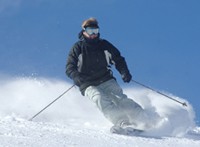For Skiers, Too Soon to Panic?
By
DAVE CALDWELLBURLINGTON, Vt., is usually a snow-covered city in December. But the weather has been so mild in the last month that snowfall is being measured by the meager inch, not by the traditional foot, and Brook Tabor, a meteorologist at the
National Weather Service office there, has become an unofficial concierge for the Burlington area.
Frustrated skiers, without enough slopes to schuss down, are calling the Weather Service office to get tips on good shops and restaurants. “We’re trying to give them some alternative things to do,” the cheerful Mr. Tabor said by telephone on Tuesday.
Throughout the Northeast, the ski season is lurching out of the gate because it has just been too balmy. Ski areas across the region are reporting less snow than usual, fewer trails open and temperatures often too warm for snow making.
But, the real question is this: Is it too soon for skiers and resort operators to panic?
The answer, for now, they say, is no. But resort employees and skiers in the Northeast tend to be optimists. They say the region’s season does not begin in earnest until Christmas, and long-range forecasts are calling for a winter that will be a little cooler and wetter than normal — good news for skiers, if not shovelers.
“When this season is over, despite the slow start, I think people will look back and say it’s been a pretty good winter,” said Herb Stevens, an independent meteorologist from North Kingston, R.I., who is known as the Skiing Weatherman.
The ski crowd does not appear worried, either. Most resorts say reservations for the week between Christmas and New Year’s Day are running normal — even a bit above normal for some — and ski clubs are not yet canceling trips to the slopes. “Every year, it’s iffy until you get to January,” said Lore Conway, of Tuxedo, N.Y., who is the president of the 100-member German Ski Club of New York.
What the lack of snow and the warm weather have done, more than anything, is scrub some of the excitement from the start of the season — think of it as the Psyche Effect. When it snows, even in
New York City, skiers tend to flock to their neighborhood ski shop for a new pair of skis or even a hat and start gazing north with longing.
“It’s just a big time of year for us, and wet weather is not what we want,” said David Wingard, a buyer for Paragon, an outfitter in
Manhattan, referring to the city’s recent warm, rainy days. Even yesterday, temperatures in New York strained toward 60 degrees — and that just doesn’t promote thoughts of heading out and hitting the slopes.
Mr. Wingard, who skis and snowboards, was at Hunter Mountain, 125 miles north of Manhattan, on Tuesday. He said it felt more like late March than mid-December. Paragon has usually scheduled ski trips to Hunter for its customers by this time each year, but not so far.
And going farther north isn’t much of a help. Mr. Tabor, the Weather Service meteorologist, said that November in Burlington was the second warmest on record, with an average temperature of 42.8 degrees — or an all-important 10.8 degrees above freezing. He said the Weather Service recorded a half-inch of snow in November atop Mount Mansfield, the state’s tallest peak (and the site of
Stowe Mountain Resort). The previous low for the month there was seven inches in 1964. The average temperature of 34.6 degrees broke a 40-year-old record by nearly 3 degrees.
Not only do ski resorts want cold weather so snow will fall, but they also need cold weather to make snow artificially and to keep it from melting into slush.
Some meteorologists are blaming the weather on a weak El Niño system in the Pacific. And temperatures, they say, are expected to remain warmer than average until nearly Christmas. And there is always the specter of
global warming.
“I honestly can’t remember it being this warm this late,” said Bill Saydah, a resident of Rivervale, N.J., who has been a member of the New York Ski Club since 1954.
The impact of the warm weather in the Northeast is being magnified this season, partly because last year’s ski season was widely considered to be memorable, and because the slopes in the West are off to a strong start.
Vail, in
Colorado, has 27 of its 33 lifts open and 177 of 193 trails, with 27 inches of snow at midmountain; a foot of powder fell between Sunday and Wednesday.
But back in the Northeast, “it’s nothing like what we would expect to see in the middle of December, but it is a marked improvement over two weeks ago, when I was out playing golf,” said Sandy Caligiore, who works for the Olympic Regional Developmental Authority, which oversees activities at Whiteface and Gore mountains in upstate New York, among other places.
So far this year, he said, skiers are finding other things to do in and around nearby Lake Placid, like taking a bobsled or luge ride or spinning around the outdoor skating oval that is open to the public.
Nothing has been scrapped from the schedule at Whiteface or Gore so far even though a United States of America Snowboard Association event scheduled to be held at Whiteface tomorrow has been postponed until Jan. 7. “We’re fighting the fight at this point,” Mr. Caligiore said.
Some skiers are content to be patient. John Sadowski, who lives in Allendale, N.J., and who has skied for 40 years, said the season has been normal for the 150-member Telemark Ski Club, which meets in
Brooklyn and has a lodge in Pittsford, Vt., not far from
Killington. But it is still early.
“This is purely personal, but skiing has always been a January-February-March sport for me,” he said. “I’ve always considered March to be the best time to ski because the weather is better, the light is better and in general, the conditions are better.”
MEANWHILE, the ski areas and resorts are doing what they can. Rich Edwards, a spokesman for the Catamount Ski Area in western
Massachusetts, said Tuesday that 6 of Catamount’s 32 trails were open, compared with the usual 10 or so at this time of year.
Hunter’s spokeswoman, Jessica Pezak, was not optimistic. “We might not have snow for Christmas,” she said, “and we almost always do.” She added that melting snow is hard to groom and that heavy traffic on the slopes tends to push that snow into the ground.
Hunter’s neighbor, Belleayre, has opened 6 of its 47 slopes. “We’re kind of used to ups and downs in the weather,” said Pat McVitty, the area’s marketing director.
Mr. Saydah said the New York Ski Club has scheduled a New Year’s Eve party at its lodge in Center
Berlin, N.Y. He did not sound sure that many of the club’s 100 members would ski at nearby Jiminy Peak in the
Berkshires or at Okemo Mountain Resort, in Ludlow, Vt.
Bonnie MacPherson, a spokeswoman at Okemo, said 32 of its 117 trails were open Tuesday — an average number. But she added that business has been slow, as it has been at most places.
“We had 100 inches of snow at this time last year,” said Judy Sweeney, who manages Snow Ridge Ski Resort in
Turin, N.Y., between Utica and Watertown. As she spoke, Snow Ridge had not opened. Usually, Ms. Sweeney said, all 22 of Snow Ridge’s trails are open by now. At least, Snow Ridge could take a little solace that larger resorts have also had trouble making, and keeping, snow.
Killington Resort, the skiing giant in southern
Vermont, opened Nov. 23, then closed Dec. 1 and 2 because of rain and warm weather, and then opened again. Closing after opening, said Killington’s spokesman, Tom Horrocks, was very unusual. “It really deteriorated,” he said of the conditions. “There was really no way around it.”
It then got cold enough to make snow and, as of Tuesday, Mr. Horrocks said, roughly 40 trails were open. On the same date last year, 60 trails were open at Killington. Forty-six trails were open on Dec. 12, 2004, he said, and 75 were open on Dec. 12, 2003.
Mountain Creek, a smaller resort in Vernon, N.J., 47 miles west of Manhattan, is not open at all. Mountain Creek has powerful machines that could pile a foot of snow inside Giants Stadium within an hour, but it has not been cold enough.
“It’s
New Jersey, and we’re used to weird December weather,” said Shannon McSweeney, a Mountain Creek spokeswoman. “More often than not, something unusual happens during the month.”
Ms. McSweeney said late Wednesday that Mountain Creek had decided to open two runs tomorrow and Sunday, only a week behind its scheduled opening. She was hopeful that the weather would turn colder and stay that way.
“We know everybody’s dying to get out in the snow,” she said.
Sometimes, the only thing skiers and operators can do is look to the skies — as they used to say in 1950s science fiction movies — and wait for a bank of leaden snow clouds to roll their way. “We’re the eternal optimists in this business,” Ms. MacPherson said. “You have to be.”









